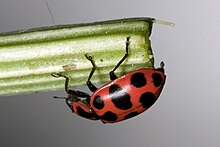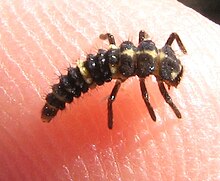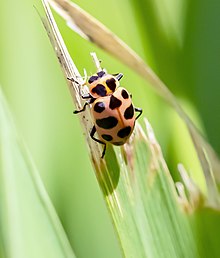
Biological control or biocontrol is a method of controlling pests, whether pest animals such as insects and mites, weeds, or pathogens affecting animals or plants by using other organisms. It relies on predation, parasitism, herbivory, or other natural mechanisms, but typically also involves an active human management role. It can be an important component of integrated pest management (IPM) programs.
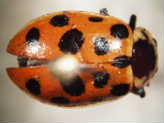
Hippodamia tredecimpunctata, commonly known as the thirteen-spot ladybeetle, is a species of lady beetle.
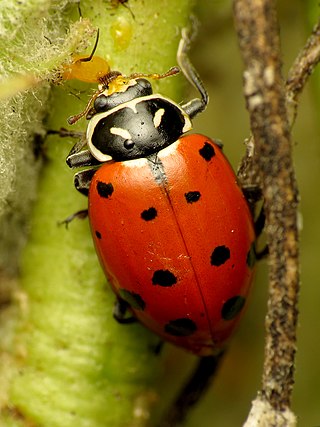
Hippodamia convergens, commonly known as the convergent lady beetle, is one of the most common lady beetles in North America and is found throughout the continent. They tend to live a variety of habitats, including grasslands and forests.
Coccinella novemnotata, the nine-spotted ladybug or nine-spotted lady beetle or C9, is a species of ladybug in the family Coccinellidae native to North America. This beetle was once ubiquitous across the continent but experienced a sharp and drastic decline around the 1960’s. Now, considered a rare species, the nine-spotted ladybug has received much attention from researchers who wish to understand the causes of its decline and restore the population of this charismatic beetle to benefit from their aphidophagous nature as biocontrol agents in agriculture.

Coccinella septempunctata, the seven-spot ladybird, is a carnivorous beetle native to the Old World and is the most common ladybird in Europe. The beetle is also found in North America, Central and Eastern Asia and regions with a temperate climate. Its elytra are of a red colour, but each punctuated with three black spots, with one further spot being spread over the junction of the two, making a total of seven spots, from which the species derives both its common and scientific names.

Diabrotica undecimpunctata, the spotted cucumber beetle or southern corn rootworm, is a species of cucumber beetle that is native to North America. The species can be a major agricultural pest insect in North America. Spotted cucumber beetles cause damage to crops in the larval and adult stages of their life cycle. Larvae feed on the roots of the emerging plants, which causes the most damage since the young plants are more vulnerable. In the adult stage the beetles cause damage by eating the flowers, leaves, stems, and fruits of the plant The beetles can also spread diseases such as bacterial wilt and mosaic virus.

Coccinellidae is a widespread family of small beetles. They are commonly known as ladybugs in North America and ladybirds in the United Kingdom; "lady" refers to mother Mary. Entomologists use the names ladybird beetles or lady beetles to avoid confusion with true bugs. The more than 6,000 described species have a global distribution and are found in a variety of habitats. They are oval beetles with a domed back and flat underside. Many of the species have conspicuous aposematic (warning) colours and patterns, such as red with black spots, that warn potential predators that they taste bad.

Coccinella undecimpunctata, the eleven-spot ladybird or eleven-spotted lady beetle, it is native to central Asia, though commonly found in Europe, and formerly North America as its populations are decreasing. It is of the family Coccinellidae, commonly referred to as ladybugs or lady beetles.

Cryptolaemus montrouzieri, common name mealybug ladybird or mealybug destroyer, is a species of ladybird beetle native to eastern Australia. The beetle feeds on mealybugs and other scale insects, and is used to control those pests on citrus orchards worldwide.
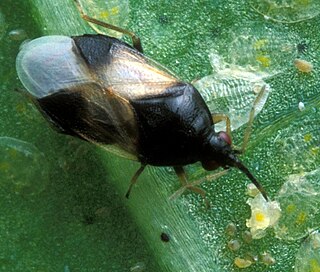
Orius insidiosus, common name the insidious flower bug, is a species of minute pirate bug, a predatory insect in the order Hemiptera. They are considered beneficial, as they feed on small pest arthropods and their eggs. They are mass-reared for use in the biological control of thrips.

Cycloneda sanguinea, also known as the spotless lady beetle, is a widespread species of ladybird beetle in the Americas.

Lebia grandis is a ground beetle in the family Carabidae found in North America. It is a specialist predator on the eggs and larvae of Colorado potato beetles, and its larvae are obligate parasitoids of Colorado potato beetle pupae.

Cheilomenes is a genus of ladybirds (Coccinellidae). Like other members of their subfamily they are large typical ladybirds. They are always shiny and often have bright spots on the elytra. The common African species C. lunata is an important predator of the citrus aphid, Toxoptera, and wheat aphid, while C. vicina has been suggested as a biological control agent for the cowpea aphid. Both the larvae and adults are predatory. Freshly emerged larvae consume unhatched eggs, and eventually have a dappled appearance and 6 tubercles on each abdominal segment. Vulnerable stages in the life of C. sexmaculata, including oviposition, hatching, moulting and pupation have been shown to occur after dark, probably as an adaptation to avoid exposure to natural enemies.
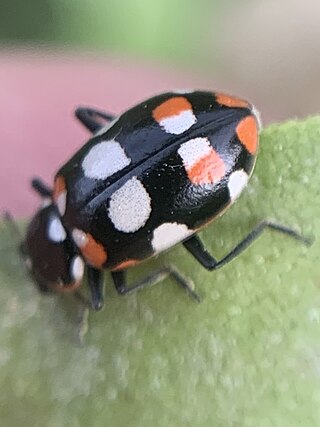
Eriopis connexa is a species of ladybird beetle that is native to South America. Both males and females mate multiple times with different individuals of the opposite sex, like most members of the family Coccinellidae. This promiscuous behavior leads to unique reproductive adaptations, such as sperm mixing. Females lay unfertilized eggs which their offspring consume upon hatching, thereby boosting offspring nutrition and reducing sibling cannibalism,. This predatory beetle species feeds primarily on aphids and is widespread throughout many agroecosystems, such as cotton, maize, sorghum, soybean, and wheat. Due to aphids being extremely damaging agricultural pests, E. connexa has been introduced to the United States for biological pest management. Recent studies on pyrethroid insecticide resistance in E. connexa have led to research by applied entomologists on the species' potential role in integrated pest management schemes in crop fields that rely on lambda-cyhalothrin (LCT), a common pyrethroid insecticide that is ineffective against aphid population control. The potential efficacy and success of the utilization of E. connexa in these programs is widely debated and is the focus of much recent research due to the lack of understanding regarding the effects of pyrethroid resistance on the behavior of this species.
Micraspis discolor is a species of ladybird. It was described by Johan Christian Fabricius in 1798. It is widespread throughout Asia, North America and parts of Oceania.
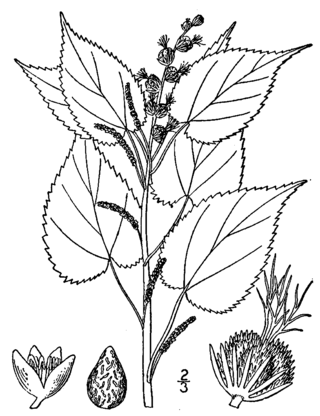
Acalypha ostryifolia, sometimes spelled ostryaefolia, is a plant in the family Euphorbiaceae and is commonly known as hophornbeam copperleaf, hornbeam copperleaf, or pineland threeseed mercury, is an annual herb of the copperleaf genus Acalypha. It is a native of North and Central America and is generally considered a weed.

Olla v-nigrum is a species in the family Coccinellidae, in the suborder Polyphaga. The species is known generally as the ashy gray lady beetle. The distribution range of Olla v-nigrum includes Central America, North America, and Oceania. It is usually gray or pale tan with small black spots on its elytra and thorax. However, a variation can resemble Chilocorus orbus, another species of lady beetle. This form is black with two red spots on the wing covers and has white on the edge of the prothorax.
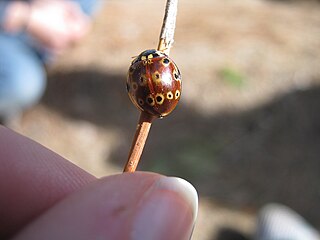
Anatis mali,, is a species of lady beetle in the family Coccinellidae. It is found in North America. Anatis mali is a crucial specialized aphid predator in the balsam tree plantation system. A rotation lasting about ten years for balsam trees to grow as Christmas trees under local temperature conditions, there is significant potential for using Anatis mali in biological management on pre-harvest trees where visual damage maintenance is not essential.
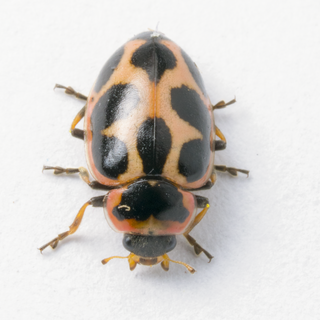
Naemia seriata, commonly known as the seaside lady beetle, is a large coccinellid beetle native to North America, and the only species in the genus Naemia. It is found in coastal areas such as beaches, salt marshes, and bay islands on the Atlantic and Pacific coast. This beetle is light brown, yellow, orange, or red in color, with large black spots, often connected along the sides. The pronotum usually has one large central black spot, which is occasionally split into two spots. The body of this species is elongately oval in shape, and between 4 and 6.7mm in length. The two subspecies can be distinguished by markings on the head, with the head of N. seriata seriata being black, while the head of N. seriata litigiosa has a pale triangular marking. Naemia seriata seriata is primarily distributed across Eastern North America, while N. seriata litigiosa is restricted to the American Southwest.

Scymnus (Scymnus) nubilus, is a species of lady beetle found in Pakistan, India, Bangladesh, Sri Lanka, Nepal, Myanmar, China, and Asia Minor.
